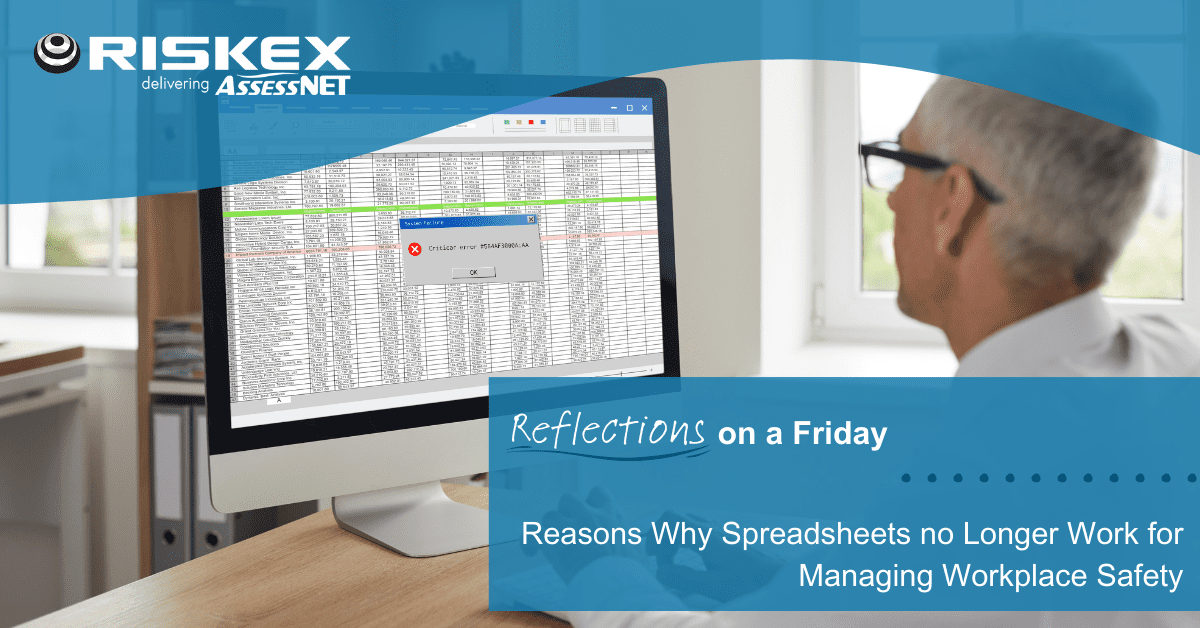
Despite the rise in digital tools within the health and safety space, spreadsheets remain a common method for managing workplace safety. Their accessibility and familiarity make them a go-to solution for many organisations.
However, as workplace safety requirements become more complex and the demand for real-time data and comprehensive compliance increases, spreadsheets are proving to be less effective and not as cost-efficient as they once used to be.
The limitations of spreadsheets in handling dynamic safety environments, preventing human errors, and providing advanced analytics, highlight the need for a more robust solution. Here are some of the most compelling reasons why spreadsheets no longer work for managing workplace safety.
Why spreadsheets no longer work for managing workplace safety
Spreadsheets are used for a variety of business purposes, particularly in accounting, data management and financial analysis. While they can be essential for some jobs, they can create risks when pushed to higher capabilities, and they can become incredibly difficult to manage across medium to large companies. Here are some compelling reasons why they no longer work:
- Errors – Spreadsheets are prone to errors, whether this is manual data entry or the use of outdated data. Even a small mistake can have significant consequences. This can be incredibly frustrating and time consuming to remedy.
- Data security – Spreadsheets have very little security and can be easily copied, shared and distributed, which could lead to data breaches.
- Scalability issues – There are issues with growth limitations with spreadsheets. As the data grows, it can be very hard to manage and slower to process. Couple this with managing complex safety programs and regulations and this could lead t0 corrupt files.
- Lack of traceability – A major factor to consider within health and safety is the lack of transparency and traceability of data entry. Audit trails are extremely important for accountability.
- Regulatory compliance – Spreadsheets do not provide features to ensure compliance with health and safety regulations, and cannot be easily updated and modified to stay in line with these regulations.
- Difficulty with sharing information – Information on spreadsheets can be siloed, making it difficult for teams to share updates and insights promptly and could lead to non-compliance without being aware of it.
- Time wasted – Maintaining and updating spreadsheets can take up employee time, especially when dealing with large amounts of data.
- Limited analytics and reporting – Spreadsheets offer basic analytical tools and lack advanced reporting capabilities, making them unfit for purpose in some cases. Visualising data trends and insights can be tricky in spreadsheets and time consuming to put into a more reportable and visual format.
What could happen if spreadsheets are used incorrectly to manage health and safety processes?
- Increased risk of accidents and injuries – Inefficient data entry and updating of spreadsheets could lead to delayed recognition of hazards and therefore slower action times.
- Regulatory non-compliance – Failure to comply with regulations can result in fines and penalties. Companies could face legal repercussions due to non-compliance and negligence in ensuring workplace safety.
- Financial losses – Poor safety records with out-of-date information and no data audit trail could result in higher insurance premiums and increased costs in compensation claims. Accidents and injuries in the workplace due to lack of action of identified hazards could lead to staff absences, production stoppages, which could affect overall business operations and profitability.
- Reputation damage – Persistent safety issues can damage a company’s reputation among employees, customers and other stakeholders. Accidents and safety violations could attract unwanted negative media attention, further damaging a company’s reputation.
- Staff retention – Frequent accidents and a lack of commitment to safety from senior management can lower employee morale and satisfaction. This could also lead to high staff turnover rates, and recruitment and training costs, which can be very costly for organisations.
Overall, spreadsheets can in some cases be an effective method for managing safety, particularly in smaller businesses, but relying solely on spreadsheets for managing workplace safety in the majority of organisations can have significant negative repercussions, highlighting the need for more sophisticated health and safety software solutions.
A few ways health and safety software like AssessNET can help your business
Improve incident reporting and response – Health and safety software allows for instant reporting of incidents and timely action and documentation. Notifications can be sent to relevant personnel to ensure the necessary actions are undertaken.
Comprehensive processes made easier – Software systems can guide people through processes such as risk assessments, reducing the chances of oversight and errors. Analytics and data trends built into the software can help identify potential hazards before they lead to accidents.
Regulatory compliance and traceable audit trails – Software can be updated to ensure all procedures comply with current laws. Software maintains thorough and accessible records of all safety related activities and changes, making audits smoother and more transparent.
Financial savings – Improved safety records and compliance can lead to lower insurance premiums. When the number of accidents is reduced due to more rigorous procedures in identifying hazards, this will minimise the financial impact of compensation costs for injuries and accidents. In addition to this, less accidents means less staff absences.
Employee morale and staff retention – When you demonstrate and commitment to the safety of your staff, you improve employee morale and job satisfaction. You can also engage employees through accessible platforms for reporting hazards.
Health and safety software offers a more efficient, reliable, and comprehensive solution for managing workplace safety, ultimately leading to a safer work environment and more successful business operations.
For more information on how AssessNET can help you improve workplace safety in your organisation, contact us today or enquire for a personal demonstration of our system
Book a demo of our system today
Latest News
Riskex Limited
BizSpace
Linford Forum
18 Rockingham Drive
Milton Keynes
Buckinghamshire
MK14 6LY
What3words reference:
Contact us
Make an enquiry:
Company No. 05174302
VAT No. 844 5092 22


